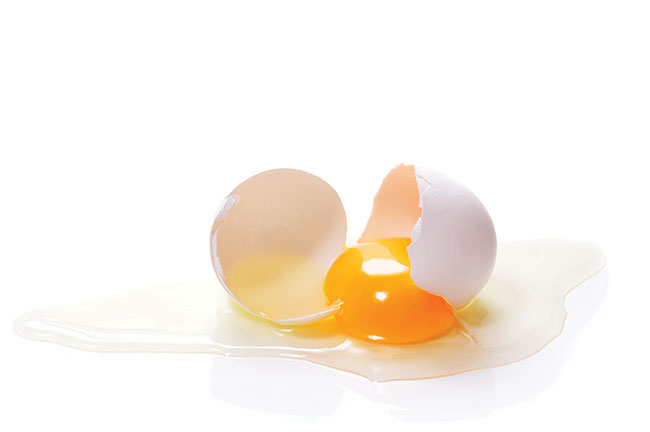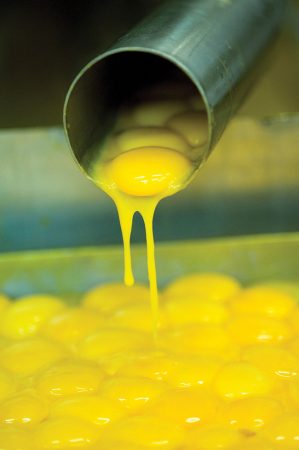
Thermal egg processing
November 18, 2021
By Matt Hale
‘Cracking’ the processing challenge with tubular heat exchangers
 Eggs contain a complex mixture of white and yolk, each with different processing requirements.
Photo courtesy HRS Heat Exchangers
Eggs contain a complex mixture of white and yolk, each with different processing requirements.
Photo courtesy HRS Heat Exchangers Eggs are a key foodstuff and ingredient. While shell-on eggs account for the bulk of this consumption, processed egg products represent 31 per cent of the market. Processed egg products can take several forms but the most common is liquid egg.
Overall consumer demand for eggs has risen steadily over the decade and North Americans increasingly want the reassurance of home-produced eggs. One reason is the recognized high production standards and food safety assurances. That quality and reassurance is also sought by the buyers of processed egg products.
Not only does this place specific requirements on the raw materials used by egg processors, but it also means that the equipment used must be of the highest quality, delivering reliable results time after time.
Egg characteristics
Fresh eggs have a thick, white and upstanding yolk. Over time, the white thins and the yolk spreads and enlarges as water passes through the membrane from the white into the yolk, weakening it. Because of this, eggs are refrigerated and processed quickly, usually within a week.
Liquid egg is a very delicate product as the proteins in egg are more sensitive to heat than other products, such as milk or juices. This is due to the fact that the white and yolk are distinct components with different compositions and behaviours. When mixed, they interact mutually – for example, egg white is denatured at 136 F while yolk is denatured at 149 F. These low temperatures also make it hard to aseptically process natural liquid egg products; the eggs are frequently cooked before the required time and temperature minimums are achieved.
Importance of pasteurization
There may be a several reasons to process eggs, including convenience and to extend shelf life or as part of other food processing and manufacturing operations. The main reason to pasteurize egg products is food safety, but other reasons include ease of use, improved hygiene and product uniformity. Depending on the exact combination of treatment time and temperature used, it is possible to produce a shelf life of up to 16 weeks for refrigerated liquid egg products.
Irrespective of the treatment method used, it is important to use fresh, clean and sanitized eggs, and to chill and filter them immediately after breaking. The contents of an egg are essentially sterile until broken, so one of the aims of processing is to reduce or eliminate any bacteria or contamination that may be introduced once the egg is cracked. Liquid whole egg and yolk should be held at or below 39 F, and egg whites below 44 F.
Yolk and whole egg products are generally pasteurized in their liquid form, while liquid egg white may be pasteurized when sold as a liquid or frozen product. In contrast, dehydrated egg yolk (with the glucose removed) is normally pasteurized by holding containers in a large chamber over several days.

There can be many reasons to process liquid egg, including convenience and improved shelf life. Photo courtesy HRS Heat Exchangers
Technical challenges
For most liquid egg products, pasteurization using heat exchangers remains the main form of heat treatment. Various time and temperature regimes are used to pasteurize eggs depending on the product, which could be whole egg; separated egg (whites or yolks); or a treated product, like salted yolk. Each type of product presents a different challenge in terms of viscosity, and products with added salt also introduce a higher likelihood of equipment degradation or corrosion.
Pasteurization can have a number of unwanted effects, including gel formation and softening of the yolk, or irreversible denaturation of the proteins and changes to the appearance. If not handled correctly, thermal pasteurization can decrease protein content, change physical characteristics such as texture and colour, and increase product viscosity. Choosing the right pasteurization regime and equipment is therefore vital to minimize and prevent such unwanted effects.
Limitations of plate and smooth-tube heat exchangers
In the past, many processors have used plate heat exchangers to pasteurize egg products, but these allow product to coagulate on the plate surface, fouling the heat exchanger so that frequent cleaning-in-place (CIP) is required to maintain operational efficiency. This adds time, energy and cost to the processing and also reduces overall capacity.
Tubular heat exchangers overcome some of these problems (for example, the larger diameter helps the product to run through the heat exchanger more easily) but there can be issues around heat transfer efficiency and the necessary size of the exchanger to achieve effective pasteurization.
Why choose corrugated heat exchangers?
Fortunately, all of these issues can be overcome with the use of corrugated tube technology as employed by HRS, which uses turbulent flow to reduce fouling. Because a corrugated tube has an increased heat transfer rate compared to a smooth tube of the same length, the heat exchanger can be made smaller.
It is also important that the equipment chosen allow regular inspection and suitable CIP. Not only do HRS corrugated tube heat exchangers facilitate this, but because their design helps to prevent fouling in the first place, they also reduce downtime. Therefore, the operational run times between cleaning cycles are generally much longer with corrugated tubes than with smooth ones, further increasing the overall efficiency of the process.
Matt Hale is the sales and marketing director for HRS Heat Exchangers.
Print this page
Leave a Reply